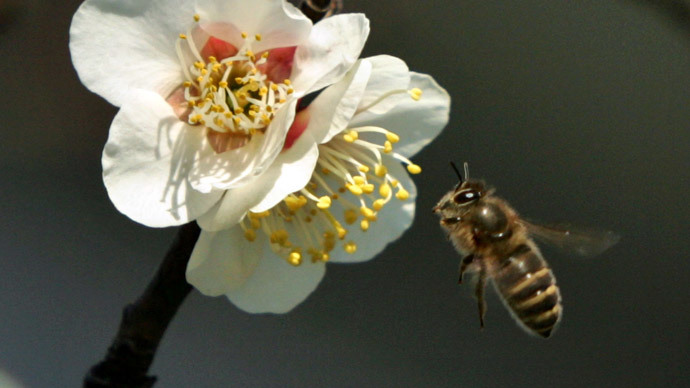EPA wants ‘pesticide-free zones’ to curb honeybee deaths

Regulators in the United States are generating a buzz by proposing new rules that would establish temporary pesticide-free zones as part of an effort to reverse the rampant die-off of commercial honeybees.
The latest offering from the US Environmental Protect Agency, or EPA, is expected to be published in the Federal Register on Friday this week. According to the Associated Press, it will call for the creation of restricted areas where pesticide use will be prohibited when certain plants are in bloom and commercial bees are trucked in to help with pollination.
Enjoying that fresh fruit? Chances are, you have a bee to thank! We’re taking action to help protect bees. http://t.co/zYs9ALAjR0
— U.S. EPA (@EPA) May 28, 2015
The proposal “doesn't eliminate (pesticide) exposure to
honeybees, but it should reduce it,” University of Illinois
entomologist May Berenbaum told AP. “It may not be ideal, but
it's the best news in about 120 years. In concept, in principle,
this is a big policy change.”
Commercial honeybees that are brought from field to field by
beekeepers account for nearly 90 percent of the species’ US
population, University of Maryland's Dennis van Englesdorp added
to AP, but they’ve been dying off in droves in recent years due
to what some say are problems posed by pesticides. The result has
hurt the US agriculture business, given that a quarter of the
food consumed by Americans is produced by plants pollinated by
honeybees, Reuters reported.
READ MORE: Beemageddon: White House reveals
national strategy to tackle honeybee decline
Jim Jones, the assistant administrator for chemical safety and
pollution prevention at EPA, said the agency wants to restrict
the use of nearly all pesticides, including those containing the
controversial chemical class known as neonicotinoids. By
implementing the rule, he says upwards of 1,000 products
involving 76 different chemical compounds would be banned from
being used in areas where honeybees are aiding with pollination
while certain plants are in bloom.
The idea is "to create greater space between chemicals that
are toxic to bees and the bees," Jones said.
"The acreage may not be large, but the impact is," Jones
said. "It's really a function of where the bees are."
Specifically, Jones told AP that the restrictions would limit
pesticide use around almond trees in February and April, and
affect what kind of chemicals can be used in April and May when
apples and melons are harvested on US farms with the help of
honeybees.
According to the US Dept. of Agriculture, the period between
April 2014 and April 2015 saw the second-highest annual loss ever
with regards to commercial bee colonies. Pending a review of
comments expected to be made in the wake of Friday’s publication,
Jones said new rules and pesticide labels could be ready by next
year.
Earlier this month, the White House unveiled its National
Strategy to Promote the Health of Honey Bees and Other
Pollinators as part of the administration-wide effort to try and
reverse the trend. The Obama administration has said it wants to
spend upwards of $82.5 million on honeybee research in the
upcoming budget year, more than double the current allocation of
$34 million.












